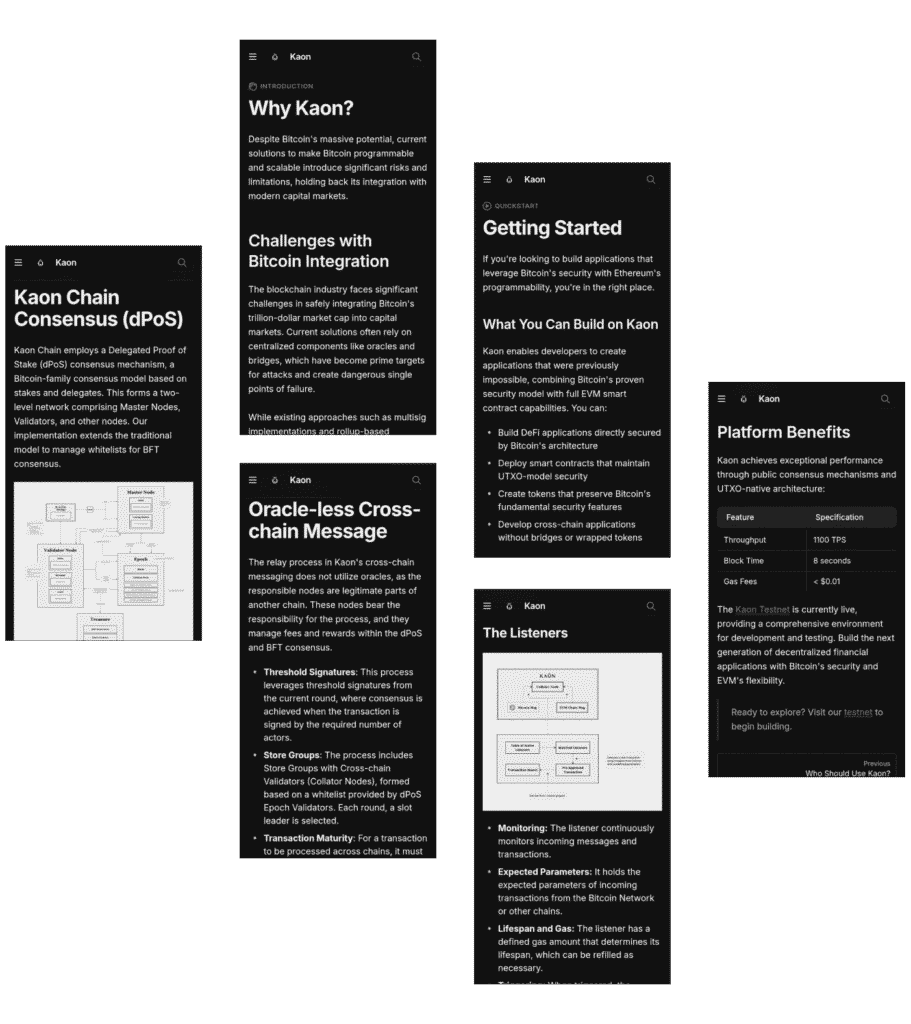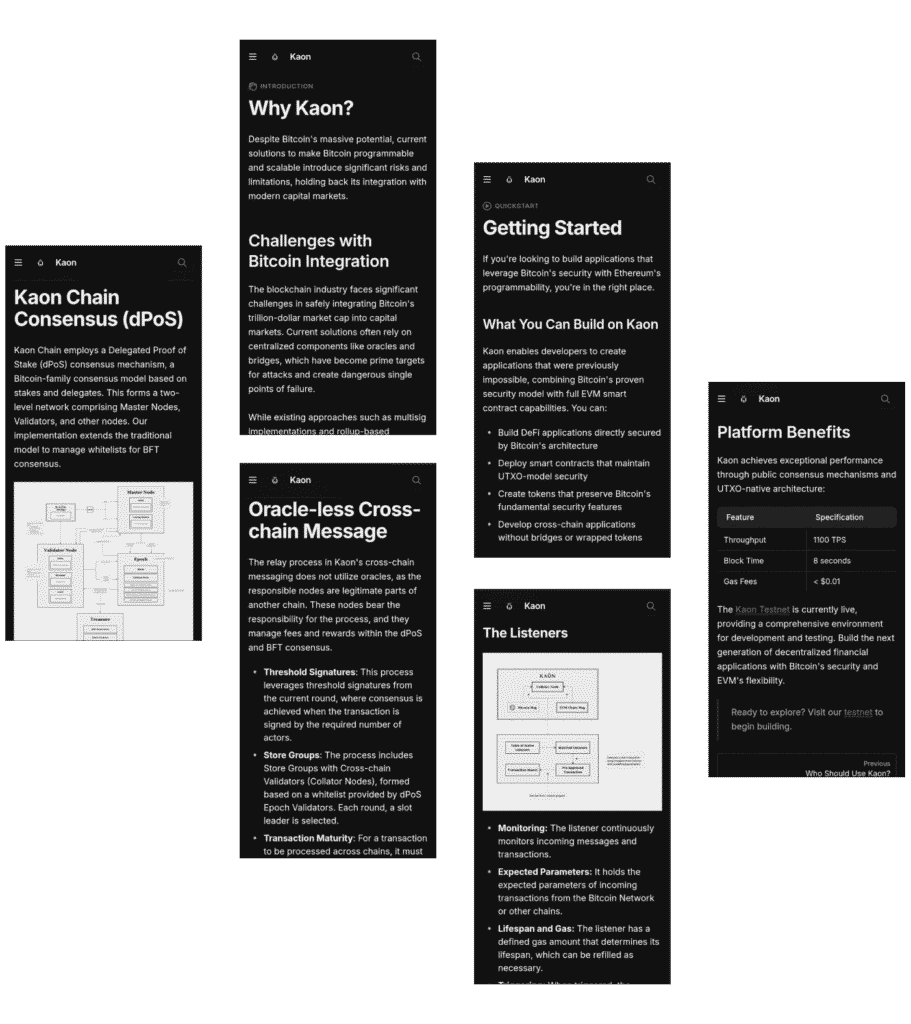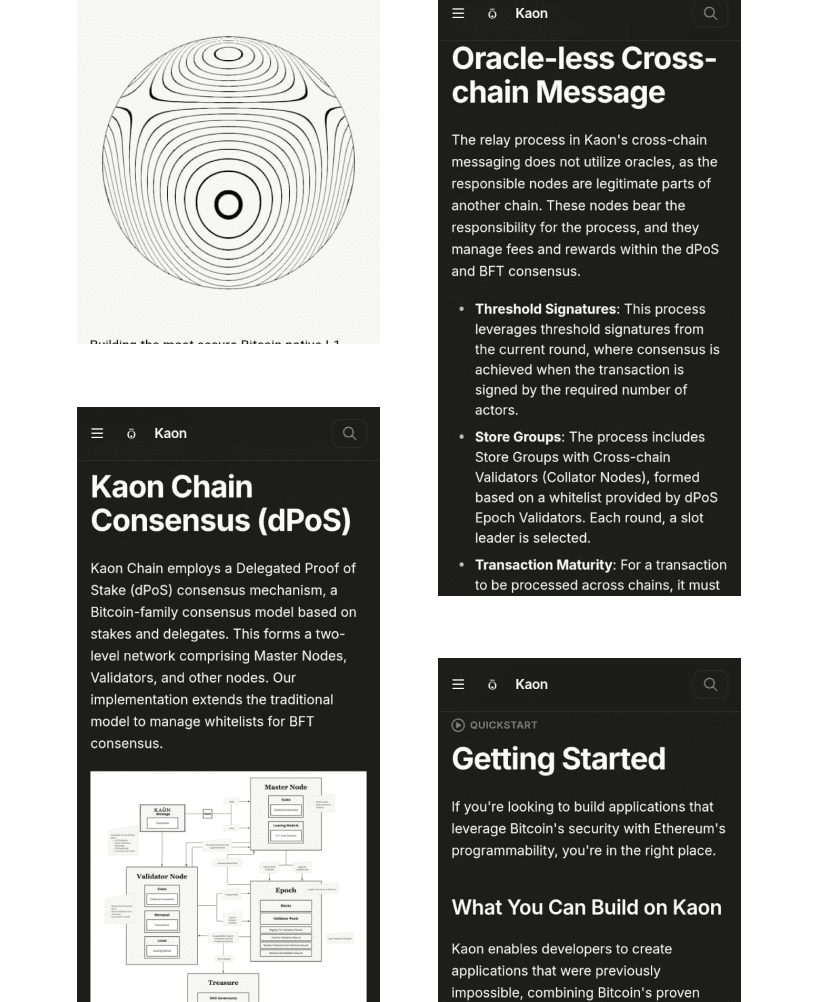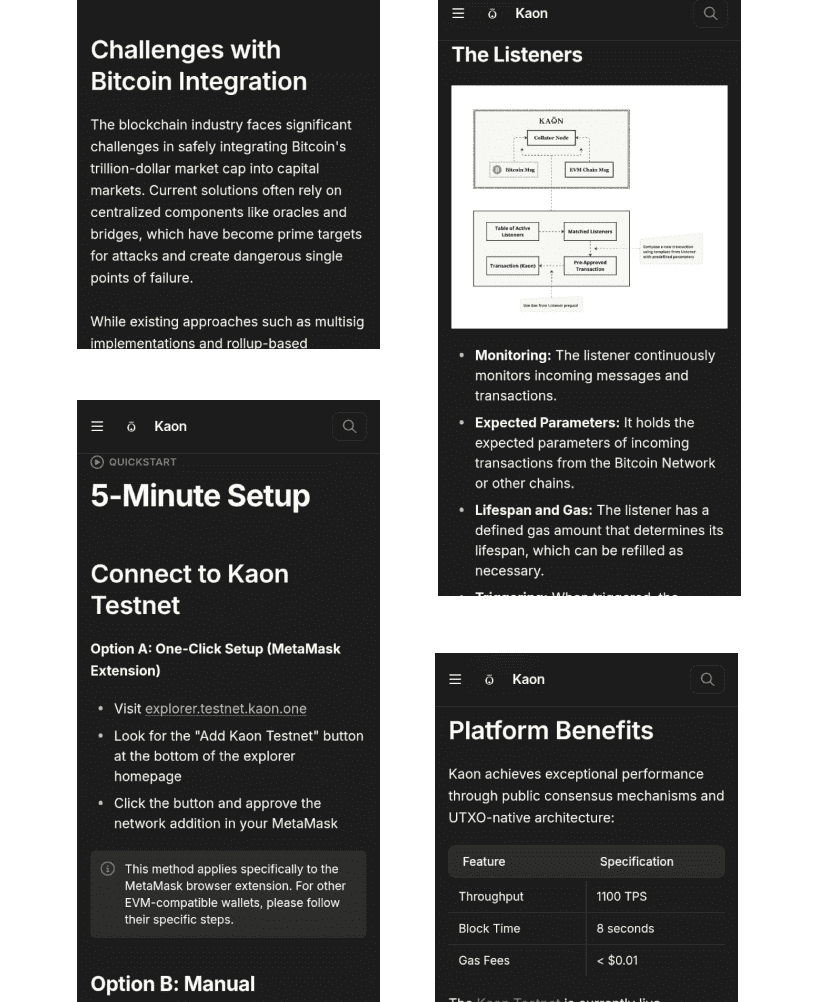Kaon
Unleashing Bitcoin’s Potential
Kaon is a hybrid blockchain infrastructure that bridges Bitcoin and Ethereum, enabling Bitcoin interoperability with Ethereum smart contracts without relying on bridges or wrapped tokens. By integrating Bitcoin’s UTXO model with Ethereum’s account-based system, Kaon allows seamless cross-chain transactions while preserving Bitcoin’s security, decentralization, and efficiency. With mirror BTC, a 1:1 BTC-backed asset, Kaon enables DeFi Applications to leverage Bitcoin liquidity natively.

Kaon
Unleashing Bitcoin’s Potential
Kaon is a hybrid blockchain infrastructure that bridges Bitcoin and Ethereum, enabling Bitcoin interoperability with Ethereum smart contracts without relying on bridges or wrapped tokens. By integrating Bitcoin’s UTXO model with Ethereum’s account-based system, Kaon allows seamless cross-chain transactions while preserving Bitcoin’s security, decentralization, and efficiency. With mirror BTC, a 1:1 BTC-backed asset, Kaon enables DeFi Applications to leverage Bitcoin liquidity natively.

Features
Get Started with this product
Kaon merges Bitcoin’s UTXO model with Ethereum’s EVM architecture to enable secure cross-chain transactions without altering Bitcoin’s base layer. This hybrid design allows developers to run smart contracts on Bitcoin while preserving its decentralized trust. With Ethereum’s tooling support like Hardhat and Remix, Kaon eliminates bridges, cutting risks and delays, uniting Bitcoin liquidity with EVM programmability.
Kaon introduces mirrorBTC, a 1:1 Bitcoin-backed asset enabling trustless DeFi without wrapped tokens. Unlike centralized custodial systems, mirrorBTC runs within Kaon’s decentralized model, ensuring security and transparency. Users deposit BTC, mint mirrorBTC, and use it for lending, staking, or DEX trading. By maintaining a direct peg, it eliminates bridge reliance and secures Bitcoin’s role in DeFi.
Kaon removes blockchain bridges by supporting native BTC transfers across EVM networks. Unlike wrapped assets that rely on oracles and custodians, Kaon enables direct interoperability through its UTXO-EVM hybrid design. Users move BTC across Ethereum and similar chains without exposing funds to bridge exploits. This innovation reduces risks, boosts efficiency, cuts fees, and makes BTC a safer DeFi asset.
Kaon makes it possible for Ethereum developers to deploy Solidity-based smart contracts interacting with Bitcoin directly. It supports frameworks like Hardhat, Truffle, and Web3.js for smooth onboarding. By merging Ethereum’s programmability with Bitcoin’s security, Kaon powers NFT markets, DeFi protocols, and cross-chain apps. Users can lend, stake, and swap BTC without centralized intermediaries or wrapped tokens.
Kaon employs Delegated Proof of Stake (dPoS) and Byzantine Fault Tolerance (BFT) for scalable and secure processing. dPoS ensures validator efficiency, while BFT guards against double-spending and attacks. This dual consensus achieves high throughput and finality, making Kaon ideal for DeFi, NFTs, and real-time dApps. Unlike energy-heavy PoW, Kaon’s model reduces costs, congestion, and ensures long-term sustainability.
Kaon enables gasless transactions, allowing users to interact with smart contracts without holding native tokens. Developers or dApps can cover fees, removing Ethereum’s gas barrier and easing adoption. By letting businesses sponsor costs, Kaon improves accessibility, lowers entry hurdles, and delivers a simple, inclusive experience for Bitcoin-powered DeFi applications.
Kaon achieves 1,100 transactions per second with 8-second block times, outpacing Bitcoin’s 7 TPS and Ethereum’s costly network. The hybrid UTXO-EVM design enhances block processing, reducing congestion and ensuring efficiency. Transactions average under $0.01, making DeFi and NFT interactions cheaper and more practical. With scalable performance, Kaon enables smooth dApp execution without bottlenecks or excessive user costs.
Kaon fosters interoperability between Bitcoin and Ethereum assets, enabling cross-chain dApps like lending, staking, and NFT marketplaces. With mirrorBTC and native BTC transfers, Kaon removes custodial risks and eliminates dependency on bridges. Users trade, stake, or lend BTC assets directly in smart contracts. This unified framework ensures better liquidity, efficient movement, and secure Web3 experiences across chains.
Client Requirements
A blockchain-focused organization sought a Bitcoin interoperability solution that could seamlessly integrate Ethereum smart contracts while preserving Bitcoin’s security and decentralization. The client required a hybrid blockchain development infrastructure that would enable cross-chain transactions without relying on bridges or wrapped tokens, eliminating common security risks. Their primary goal was to unlock Bitcoin liquidity for DeFi applications, allowing BTC holders to participate in staking, lending, and borrowing without altering Bitcoin’s fundamental architecture. To achieve this, they needed a UTXO-EVM hybrid model that allows developers to build smart contracts and decentralized applications (dApps) using Ethereum-compatible tools while maintaining the integrity of Bitcoin transactions.
Additionally, the client wanted a secure and scalable framework that ensures a 1:1 BTC backing within the ecosystem, preventing issues like asset duplication or manipulation. They required low fees, fast transactions, and high network efficiency to encourage adoption by both developers and users. The Delegated Proof of Stake (dPoS) and Byzantine Fault Tolerance (BFT) mechanisms were essential to maintaining trustless and decentralized transaction validation, ensuring that Kaon could provide secure, efficient, and scalable cross-chain interactions while upholding Bitcoin’s core principles.
More Screens

dPoS for Efficient Validation
Kaon applies Delegated Proof of Stake to maximize scalability and transaction throughput. Instead of relying on Bitcoin’s power-hungry mining, dPoS empowers token holders to stake and elect validators. This system improves speed, reduces congestion, and guarantees rapid finality. Stake-based governance encourages decentralization while lowering transaction costs significantly.
BFT for Network Security
Kaon integrates Byzantine Fault Tolerance to secure consensus and deliver finality within seconds. Even if malicious validators exist, BFT sustains network stability without forks or double spending. This ensures reliable confirmations faster than Proof of Work. When combined with Delegated Proof of Stake, it strengthens scalability, resilience, and transaction trustworthiness.
Bitcoin PoW for Trustless Security
Kaon integrates Bitcoin’s Proof of Work consensus for trustless security, guaranteeing immutability and transaction verification. Unlike systems relying solely on PoS, this hybrid approach ensures robustness. By leveraging Bitcoin’s infrastructure, Kaon prevents manipulation, secures cross-chain interactions, and enhances decentralized applications with added reliability and trust.
MultiSig for Secure Transactions
Kaon utilizes Multi-Signature (MultiSig) to safeguard transactions by requiring multiple approvals. This decentralizes authority, reduces fraud risks, and secures enterprise-level financial activity. MultiSig prevents single points of failure while supporting institutions, custodial services, and DeFi protocols. It ensures trust, transparency, and reliable multi-party execution.
Kaon integrates state channels to process transactions off-chain before finalizing on-chain when necessary. This drastically reduces fees, congestion, and execution time, enabling instant interactions. State channels benefit gaming, DeFi trading, and microtransactions. They improve scalability, efficiency, and provide seamless real-time user experience.
Kaon introduces Dynamic Block Finality to ensure immediate, irreversible transactions. Unlike Bitcoin confirmations requiring time, this mechanism finalizes securely within seconds. By merging dPoS and BFT, it prevents forks, double-spending, and reversals. This guarantees reliability for DeFi, NFTs, and time-sensitive blockchain applications.
Kaon uses Threshold Signature Scheme (TSS) for secure key management, splitting private keys among multiple parties. Transactions need multiple approvals, preventing theft and centralization risks. This trustless system enhances security for enterprises, multi-party operations, and efficient digital asset management across blockchain ecosystems.
Kaon implements decentralized governance, enabling community-led decision-making. Token holders stake to vote on upgrades, protocol changes, and policies. This fosters transparency, adaptability, and rapid responses to threats. Governance ensures innovation, stability, and user empowerment, preventing centralization while enabling efficient long-term growth across the blockchain network.
Colors & Typography
Visual identity and design elements
Primary font family and usage

Color Palette
Brand colors
#000000
#f8f6f3
Project Approach & Results
Project Approach: Kaon’s development followed a structured and research-driven methodology to seamlessly integrate Bitcoin’s UTXO model with Ethereum’s EVM architecture. The first phase focused on analyzing Bitcoin’s transaction lifecycle and Ethereum’s smart contract environment to create a hybrid state model that preserves Bitcoin’s security while enabling EVM-based programmability. The team designed mirrorBTC, a 1:1 BTC-backed asset, allowing native Bitcoin transactions within Kaon without wrapping or bridging. To eliminate reliance on third-party bridges, Kaon introduced Vouchers, a mechanism enabling trustless cross-chain interactions while ensuring fast and secure asset transfers between Bitcoin and Ethereum.
In the implementation phase, Kaon’s consensus mechanisms—a combination of Delegated Proof of Stake (dPoS) and Byzantine Fault Tolerance (BFT)—were deployed to achieve high transaction throughput and finality without compromising decentralization. Secure Multi-Party Computation (sMPC) was incorporated to manage Bitcoin locks and ensure transaction validation without intermediaries.
Project Results: Kaon successfully achieved seamless Bitcoin-Ethereum interoperability, allowing developers to build Bitcoin-powered smart contracts without requiring wrapped tokens or centralized bridges. By integrating Bitcoin’s UTXO model with Ethereum’s EVM framework, Kaon enabled trustless, cross-chain transactions while maintaining Bitcoin’s security and decentralization. The introduction of mirrorBTC provided a 1:1 BTC representation within the ecosystem, allowing users to participate in DeFi applications such as lending, staking, and automated market-making (AMM) platforms. Kaon’s Byzantine Fault Tolerance (BFT) and Delegated Proof of Stake (dPoS) consensus mechanisms ensured that transactions remained secure, scalable, and efficient, significantly improving throughput and reducing finality times.
Additionally, Kaon’s gasless transactions and optimized fee model made DeFi more accessible and cost-effective for both retail and institutional users. The platform’s high transaction throughput (1,100 TPS) and low gas fees (<$0.01) created a scalable infrastructure for cross-chain financial applications.

Ensuring Cross-Chain Security Without Bridges
One of the biggest challenges Kaon faced was enabling trustless cross-chain transactions without relying on bridges or centralized intermediaries. Traditional cross-chain solutions use wrapped tokens and oracles, which introduce significant security risks, including potential hacks and fraud. To address this, Kaon implemented mirrorBTC, a direct 1:1 BTC-backed asset, eliminating third-party dependencies. However, ensuring seamless and secure asset mirroring between Bitcoin and Kaon’s consensus layer required advanced cryptographic techniques, such as Threshold Signature Schemes (TSS) and Secure Multi-Party Computation (sMPC), to prevent double-spending and unauthorized transactions, making development highly complex.
Balancing Speed, Scalability, and Bitcoin’s Security Model
Bitcoin’s Proof-of-Work (PoW) model is highly secure but slow, limiting its ability to support high-speed financial applications. Kaon needed to increase transaction throughput without compromising Bitcoin’s security principles. By integrating Delegated Proof of Stake (dPoS) and Byzantine Fault Tolerance (BFT) consensus, Kaon achieved faster transaction finality while maintaining decentralization. However, optimizing these consensus mechanisms while ensuring that transactions remained trustless and verifiable within Bitcoin’s UTXO model was a complex process.
Encouraging Developer Adoption and Ecosystem Growth
Since Bitcoin developers are accustomed to UTXO scripting, and Ethereum developers work with Solidity and the account-based model, getting both groups to build on Kaon was challenging. The hybrid model required new tools, documentation, and developer support to make adoption easy. The team introduced EVM compatibility, allowing Ethereum developers to use Truffle, Hardhat, and Web3.js, while Bitcoin developers could continue working with Bitcoin-native scripts.

This concise overview highlights the key components of the technology stack powering INRx Pay, ensuring secure, efficient, and seamless transactions for its users.





